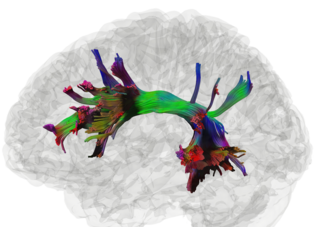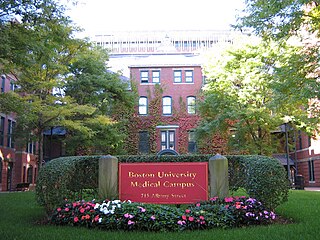
Neurosurgery or neurological surgery, known in common parlance as brain surgery, is the medical specialty concerned with the surgical treatment of disorders which affect any portion of the nervous system including the brain, spinal cord and peripheral nervous system.

A concussion, also known as a mild traumatic brain injury (mTBI), is a head injury that temporarily affects brain functioning. Symptoms may include loss of consciousness; memory loss; headaches; difficulty with thinking, concentration, or balance; nausea; blurred vision; dizziness; sleep disturbances, and mood changes. Any of these symptoms may begin immediately, or appear days after the injury. Concussion should be suspected if a person indirectly or directly hits their head and experiences any of the symptoms of concussion. Symptoms of a concussion may be delayed by 1–2 days after the accident. It is not unusual for symptoms to last 2 weeks in adults and 4 weeks in children. Fewer than 10% of sports-related concussions among children are associated with loss of consciousness.

A discectomy is the surgical removal of abnormal disc material that presses on a nerve root or the spinal cord. The procedure involves removing a portion of an intervertebral disc, which causes pain, weakness or numbness by stressing the spinal cord or radiating nerves. The traditional open discectomy, or Love's technique, was published by Ross and Love in 1971. Advances have produced visualization improvements to traditional discectomy procedures, or endoscopic discectomy. In conjunction with the traditional discectomy or microdiscectomy, a laminotomy is often involved to permit access to the intervertebral disc. Laminotomy means a significant amount of typically normal bone is removed from the vertebra, allowing the surgeon to better see and access the area of disc herniation.

Degenerative disc disease (DDD) is a medical condition typically brought on by the normal aging process in which there are anatomic changes and possibly a loss of function of one or more intervertebral discs of the spine. DDD can take place with or without symptoms, but is typically identified once symptoms arise. The root cause is thought to be loss of soluble proteins within the fluid contained in the disc with resultant reduction of the oncotic pressure, which in turn causes loss of fluid volume. Normal downward forces cause the affected disc to lose height, and the distance between vertebrae is reduced. The anulus fibrosus, the tough outer layers of a disc, also weakens. This loss of height causes laxity of the longitudinal ligaments, which may allow anterior, posterior, or lateral shifting of the vertebral bodies, causing facet joint malalignment and arthritis; scoliosis; cervical hyperlordosis; thoracic hyperkyphosis; lumbar hyperlordosis; narrowing of the space available for the spinal tract within the vertebra ; or narrowing of the space through which a spinal nerve exits with resultant inflammation and impingement of a spinal nerve, causing a radiculopathy.
Ralph Bingham Cloward was an American neurosurgeon, best known for his innovations in spinal neurosurgery. Cloward is known for the development of the Posterior Lumbar Interbody Fusion and Anterior Cervical Discectomy and Fusion. Cloward moved from Chicago to Hawaii in 1938, becoming the state's lone neurosurgeon. He is well known for his work treating victims of brain injuries after the Pearl Harbour attack in 1941.

Chronic traumatic encephalopathy (CTE) is a neurodegenerative disease linked to repeated trauma to the head. The encephalopathy symptoms can include behavioral problems, mood problems, and problems with thinking. The disease often gets worse over time and can result in dementia.

Andre Maurice Waters was an American professional football player who was a safety for the Philadelphia Eagles and Arizona Cardinals of the National Football League (NFL) from 1984 to 1995. Waters was regarded as one of the NFL's most aggressive players, serving as an integral part of one of the league's top defenses. On November 20, 2006, Waters died by suicide and was subsequently diagnosed with chronic traumatic encephalopathy (CTE). He is one of at least 345 NFL players to be diagnosed after death with CTE, which is caused by repeated hits to the head.
Frederick Arnold McNeill was an American professional football player who was a linebacker for the Minnesota Vikings of the National Football League (NFL) for 12 seasons from 1974 to 1985. He played college football for the UCLA Bruins. In 1973, he was named to the All-Coast/Conference First-team. McNeil was selected by the Vikings in the first round of the 1974 NFL Draft with the 17th overall selection. He was the first person to have been diagnosed with CTE while alive and have it confirmed following his death.
Ron Johnson was an American professional football cornerback. He played seven seasons in the National Football League (NFL) for the Pittsburgh Steelers.

Ayub Khan Ommaya, MD, ScD (hc), FRCS, FACS was a Pakistani American neurosurgeon and the inventor of the Ommaya reservoir. The reservoir is used to provide chemotherapy directly to the tumor site for brain tumors. Ommaya was also a leading expert in traumatic brain injuries.

Dr. Bennet Ifeakandu Omalu is a Nigerian and American physician, forensic pathologist and neuropathologist who was the first to discover and publish findings on chronic traumatic encephalopathy (CTE) in American football players while working at the Allegheny County coroner's office in Pittsburgh. He later became the chief medical examiner for San Joaquin County, California, and is a professor at the University of California, Davis, department of medical pathology and laboratory medicine. He is currently the President and Medical Director of Bennet Omalu Pathology.
Concussions and play-related head blows in American football have been shown to be the cause of chronic traumatic encephalopathy (CTE), which has led to player deaths and other debilitating symptoms after retirement, including memory loss, depression, anxiety, headaches, stress, and sleep disturbances.
Minimally invasive spine surgery, also known as MISS, has no specific meaning or definition. It implies a lack of severe surgical invasion. The older style of open-spine surgery for a relatively small disc problem used to require a 5-6 inch incision and a month in the hospital. MISS techniques utilize more modern technology, advanced imaging techniques and special medical equipment to reduce tissue trauma, bleeding, radiation exposure, infection risk, and decreased hospital stays by minimizing the size of the incision. Modern endoscopic procedures can be done through a 2 to 5 mm skin opening. By contrast, procedures done with a microscope require skin openings of approximately one inch, or more.

Parviz Kambin was an American-Iranian medical doctor and orthopaedic surgeon. He was a Professor of Orthopaedic Surgery and has established an Endowed Chair of Spinal Surgery Research at Drexel University College of Medicine. He published more than 55 articles in peer-reviewed journals, edited two textbooks and contributed chapters in spinal surgery textbooks. He lectured worldwide in the field of minimally invasive spinal surgery. His research and development in this specialty began in 1970.

High definition fiber tracking (HDFT) is a tractography technique where data from MRI scanners is processed through computer algorithms to reveal the detailed wiring of the brain and to pinpoint fiber tracts. Each tract contains millions of neuronal connections. HDFT is based on data acquired from diffusion spectrum imaging and processed by generalized q-sampling imaging. The technique makes it possible to virtually dissect 40 major fiber tracts in the brain. The HDFT scan is consistent with brain anatomy unlike diffusion tensor imaging (DTI). Thus, the use of HDFT is essential in pinpointing damaged neural connections.

Concussion is a 2015 American biographical sports drama film written and directed by Peter Landesman, based on the exposé "Game Brain" by Jeanne Marie Laskas, published in 2009 by GQ magazine. Set during the 2000s, the film stars Will Smith as Bennet Omalu, a forensic pathologist who fights against the National Football League trying to suppress his research on chronic traumatic encephalopathy (CTE) brain degeneration suffered by professional football players.
Stewart Dunsker M.D., a neurosurgeon, is Professor and Director of Spinal Neurosurgery at the University of Cincinnati College of Medicine, and Director of the Department of Neurosurgery at the Christ Hospital, Cincinnati, Ohio.

The Boston University CTE Center is an independently run medical research lab located at the Boston University School of Medicine. The Center focuses on research related to the long-term effects of brain trauma and degenerative brain diseases, specializing in the diagnosis and analysis of chronic traumatic encephalopathy (CTE). According to researchers at Boston University, CTE is a brain disease involving progressive neurological deterioration common in athletes, military personnel, and others who have a history of brain trauma. The disease is primarily caused by repeated blows to the head, some of which result in concussions or sub-concussive symptoms.
Most documented cases of chronic traumatic encephalopathy have occurred in many athletes involved in contact sports such as boxing, American football, wrestling, ice hockey, mixed martial arts, rugby and soccer. Other risk factors include being in the military, prior domestic violence, and repeated banging of the head. The exact amount of trauma required for the condition to occur is unknown. Below is a list of notable cases of CTE in sports.
Daniel H. Daneshvar is an American neuroscientist, brain injury physician, and physiatrist. He is known for his academic work in traumatic brain injury and the long-term consequences of repetitive head impacts, including chronic traumatic encephalopathy (CTE). He also founded Team Up Against Concussions, the first scientifically validated concussion education program for children. He is the Director of the Institute for Brain Research and Innovation at TeachAids, which created CrashCourse, a virtual-reality or video based concussion education program.










